“WIJ EN DE WERELD: multiple perspectives in the portrayal of the Surinamese: 1873-2013” 16.11-28.12.2013
November 16, 2013 2:23 pm|
Anthropologists in Art and BukuBooks Bibliotheca Surinamica are proud to present: US AND THE WORLD
|
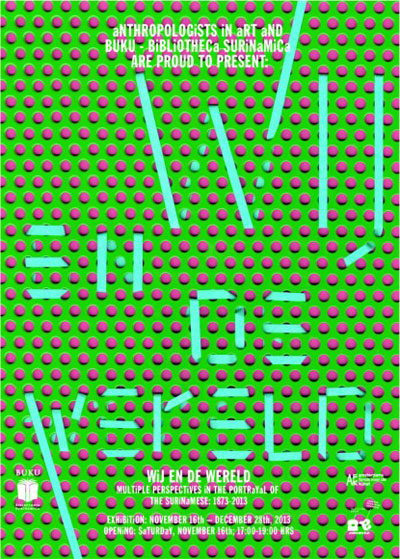 Invite by: Lesley Moore |
|
| 2013 marks the 150-year abolition of slavery by the Dutch in their colony of Surinam. A little known fact is that the in 1863, the former slaves were forbidden to leave the plantation of their masters. A caveat in the abolition decreed that ex-slaves were to continue working the plantations for another 10 years, albeit for minimal wages. Part Western civilizational rhetoric and part concession to the Dutch planters, it afforded them time to solve the predicted labour shortage that would arise as the erstwhile slaves were expected leave the plantations for the city of Paramaribo; an incorrect assumption as it turned out. As 1873 finally rolled around, the Dutch colony found itself in the process of a drastic change in its ethnic make-up.
Turning to the English format of indentured labour, the Dutch imported sizeable groups of destitute and hopeful labourers from the Dutch East-Indies (Java, Indonesia), Manchuria (China) and British India (Bihar, Uttar Pradesh), promising good wages, housing and ultimately; prosperity. |
| In “Wij en de Wereld: multiple perspectives in the portrayal of the Surinamese: 1873-2013”, Anthropologists in Art delve into the period following the abolition of slavery, roughly from 1873 to the present. AiArt’s point of departure is how Surinamese society has been represented and has reinvented itself as the more recent arrivals of Javanese, Chinese and British-Indians (Hindoestani) negotiated a place for themselves amongst the colony’s earlier inhabitants (Amerindians, Maroons, Creoles, Jews and ethnic Dutch). In what must have been a dramatic social and ethnic shift within the colony, it forms the basis of the independent republic of Suriname today. | 2013 markeert de 150-jarige afschaffing van de slavernij door de Nederlanders in hun kolonie van Suriname. Een wrang feit is dat de voormalige slaven nog 10 jaar lang verplicht waren om te werken op de plantages van hun vroegere meesters, zij het nu voor een minimaal loon. Deels Westerse beschavingsretoriek en deels concessie aand de Nederlandse plantagehouders, bood het hen de tijd om het voorspelde tekort aan arbeidskrachten het hoofd te bieden. Toen 1873 eindelijk aanbrak, brak ook een periode van drastische verandering aan in de Nederlandse kolonie, vooral met betrekking tot de sociale structuur en etnische compositie van het land. | |
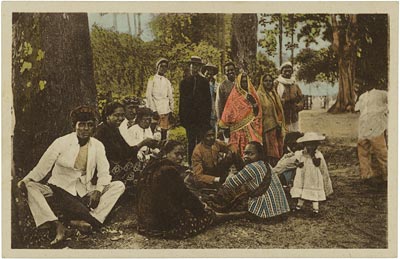
“Wij en de Wereld: multiple perspectives: 1873-2013
|
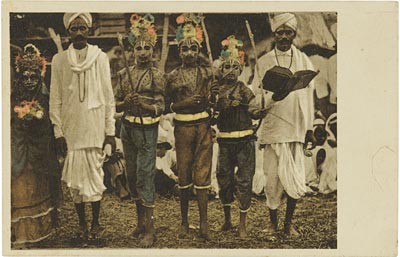
“Wij en de Wereld: multiple perspectives: 1873-2013
|
|
| Instead of taking focal points in Suriname’s history as a means of exemplification, AiArt have decided instead to focus on several popular cultural media, showcasing various visual and textual portrayals of the Surinamese people within the history of this former Dutch colony, as it developed from a slave-colony to the independent country it is today. Largely indebted to Bibliotheca Surinamica’s (accessible through the website www.buku.nl by Carl Haarnack) vivid collection, AiArt have taken the popular cultural media of the postcard, the magazine and the music video clip (mostly from the srananpoku.org website) as the nodal points of investigation. Starting from photographic and illustrative documentation from the end of the 19th and beginning of the 20th century, many different series of postcards were produced and sold representing the various ethnic groups in the para-scientific manner of categorisation that was so much in vogue at the time. Continuing, the Afro-American emancipatory ‘Ebony’- magazine published a vivid reportage in 1968 of a multi-racial paradise, focussing on the beauty of Suriname’s bikini-clad girls. Lastly, AiArt turn to music video-clips, largely produced by and for the Surinamese community (within Suriname itself as well as the Surinamese diaspora), that showcase how contemporary youth choose to represent themselves to themselves and the world at large.
In a bid to counter over-simplifications in popular conceptions of history, Anthropologists in Art have decided to present fragmentary, multi-layered visual and textual representations of Suriname’s historical ethno-genesis. |
De Nederlanders pasten de Britse blauwdruk van het importeren van contractarbeiders toe; omvangrijke groepen van berooide en hoopvolle arbeiders werden geronseld uit Nederlands-Indieë, China en Brits-Indieë, met beloftes van een goed loon, huisvesting en uiteindelijk, welvaart.
In “Wij en de Wereld: meerdere perspectieven in de afbeelding van Surinamers: 1873-2013”, richten Anthropologists in Art zich op de periode vanaf 1873 tot heden. Hierbij richt AiArt zich op afbeeldingen uit de populaire cultuur; ansichtkaarten, tijdschriften, postzegels, videoclips waarop de Surinaamse samenleving in al haar diversiteit wordt afgebeeld. Afgevraagd wordt hierbij hoe het sociale onderhandelingsproces tussen de recentere nieuwkomers van Javaanse, Chinese en Britse–Indische (Hindoestanen) afkomst en de vroegere bewoners (Amerindieërs, Marrons, Creolen, Joden en etnische Nederlanders) binnen de kolonie vorm krijgt en de basis genereert van de onafhankelijke republiek Suriname vandaag de dag. De tentoonstelling bestaat voor een groot gedeelte uit beeldmateriaal (met name ansichtkaarten) afkomstig uit de collectie Buku-Bibliotheca Surinamica (toegankelijk via de website www.buku.nl van Carl Haarnack); de fotografische en illustratieve documentatie van het eind van de 19de en begin 20ste eeuw, die als ansichtkaarten werden geproduceerd. Daarnaast laat de tentoonstelling uitéénlopende uitingen van populair-culturele representaties zien: uit tijdschriften, postzegel design en videoclips waarin de samenstelling en representatie van de Surinaamse samenleving gepresenteerd worden door de tijd heen tot anno nu. |
|
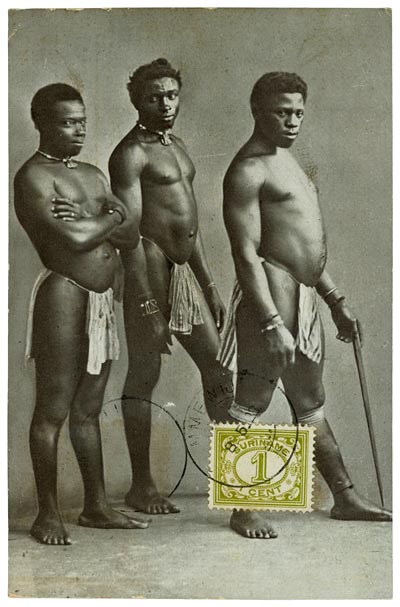 “Wij en de Wereld: multiple perspectives: 1873-2013 |
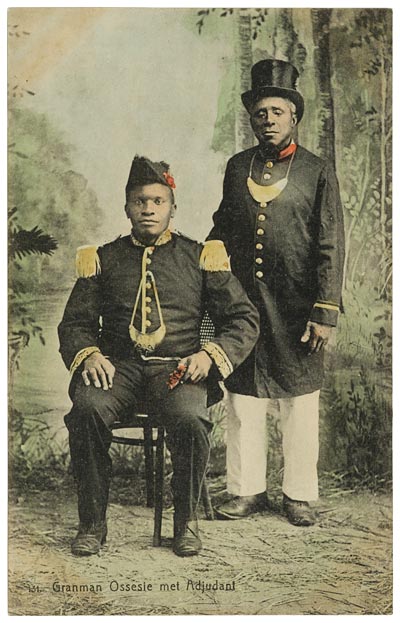 “Wij en de Wereld: multiple perspectives: 1873-2013 |
| As part and parcel of the “Wij en de Wereld – Popular cultural portrayals of the Surinamese: 1873-2013” exhibition, AiArt, in conjunction with cultural analyst Marie Bromander, BukuBooks Bibliotheca Surinamica and Professor of Cultural Anthropology Alex van Stipriaan (Erasmus University Rotterdam & Tropenmuseum curator), have created a film programme and discussion-afternoon (ScreenTalk) that aims to deepen the understanding of the ethno-historical development of this fascinating country.
ScreenTalk: Sunday, November 17th; 14:30-18:00 hrs Screened movies during ScreenTalk: De Laatste Kantraki (dir: Ramdjan Abdoelrahman), Back to the Roots (dir: Alex van Stipriaan / Dineke Stam), SAAMAKA (dir: Karl Doing). |
In een poging om over-simplificaties tegen te gaan in de populaire opvattingen over de geschiedenis, hebben Anthropologists in Art besloten fragmentarische en gelaagde visuele en tekstuele representaties van Surinames historische etno-genese te presenteren. Als onderdeel van de “Wij en de Wereld: meerdere perspectieven in de afbeelding van Surinamers: 1873-2013”- tentoonstelling, presenteert AiArt, in combinatie met Buku – Bibliotheca Surinamica, cultureel analist Marie Bromander, Algemene Cultuurwetenschapper Britt-Marie van der Drift en Professor Caribische Geschiedenis Alex van Stipriaan (Erasmus Universiteit Rotterdam & curator Tropenmuseum), een filmprogramma en discussie – middag (ScreenTalk), gericht op verdieping en inzicht in de etno-historische ontwikkeling van dit fascinerende land.
ScreenTalk: zondag 17 november, 14:30-18:00 uur Films ScreenTalk: De Laatste Kantraki (dir: Ramdjan Abdoelrahman), Op Zoek naar Roots (dir: Alex van Stipriaan / Dineke Stam), SAAMAKA (dir: Karl Doing). |
|
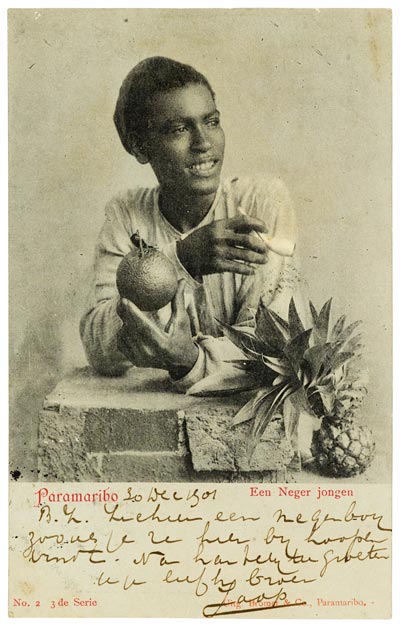 “Wij en de Wereld: multiple perspectives: 1873-2013 |
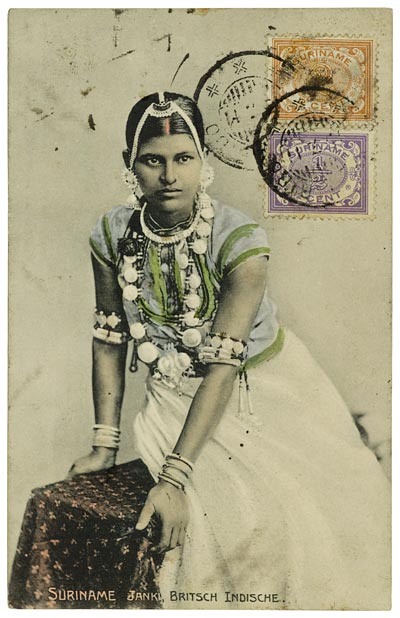 “Wij en de Wereld: multiple perspectives: 1873-2013 |
